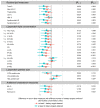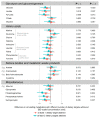Achievement of the Targets of the 20-Year Infancy-Onset Dietary Intervention-Association with Metabolic Profile from Childhood to Adulthood
- PMID: 33562015
- PMCID: PMC7915301
- DOI: 10.3390/nu13020533
Achievement of the Targets of the 20-Year Infancy-Onset Dietary Intervention-Association with Metabolic Profile from Childhood to Adulthood
Abstract
The Special Turku Coronary Risk Factor Intervention Project (STRIP) is a prospective infancy-onset randomized dietary intervention trial targeting dietary fat quality and cholesterol intake, and favoring consumption of vegetables, fruit, and whole-grains. Diet (food records) and circulating metabolites were studied at six time points between the ages of 9-19 years (n = 549-338). Dietary targets for this study were defined as (1) the ratio of saturated fat (SAFA) to monounsaturated and polyunsaturated fatty acids (MUFA + PUFA) < 1:2, (2) intake of SAFA < 10% of total energy intake, (3) fiber intake ≥ 80th age-specific percentile, and (4) sucrose intake ≤ 20th age-specific percentile. Metabolic biomarkers were quantified by high-throughput nuclear magnetic resonance metabolomics. Better adherence to the dietary targets, regardless of study group allocation, was assoiated with higher serum proportion of PUFAs, lower serum proportion of SAFAs, and a higher degree of unsaturation of fatty acids. Achieving ≥ 1 dietary target resulted in higher low-density lipoprotein (LDL) particle size, lower circulating LDL subclass lipid concentrations, and lower circulating lipid concentrations in medium and small high-density lipoprotein subclasses compared to meeting 0 targets. Attaining more dietary targets (≥2) was associated with a tendency to lower lipid concentrations of intermediate-density lipoprotein and very low-density lipoprotein subclasses. Thus, adherence to dietary targets is favorably associated with multiple circulating fatty acids and lipoprotein subclass lipid concentrations, indicative of better cardio-metabolic health.
Keywords: diet; metabolic profiling; metabolomics; primordial prevention; quality of diet.
Conflict of interest statement
The authors have no conflicts of interest relevant to this article to disclose.
Figures



References
-
- McGill H.C., Jr., McMahan C.A., Herderick E.E., Tracy R.E., Malcom G.T., Zieske A.W., Strong J.P. Effects of coronary heart disease risk factors on atherosclerosis of selected regions of the aorta and right coronary artery. PDAY Research Group. Pathobiological Determinants of Atherosclerosis in Youth. Arter. Thromb. Vasc. Biol. 2000;20:836–845. doi: 10.1161/01.ATV.20.3.836. - DOI - PubMed
-
- Berenson G.S., Srinivasan S.R., Bao W., Newman W.P., 3rd, Tracy R.E., Wattigney W.A. Association between multiple cardiovascular risk factors and atherosclerosis in children and young adults. The Bogalusa Heart Study. N. Engl. J. Med. 1998;338:1650–1656. doi: 10.1056/NEJM199806043382302. - DOI - PubMed
-
- Expert Panel on Integrated Guidelines for Cardiovascular Health and Risk Reduction in Children and Adolescents, National Heart, Lung, and Blood Institute. Expert panel on integrated guidelines for cardiovascular health and risk reduction in children and adolescents: Summary report. Pediatrics. 2011;128(Suppl. 5):S213–S256. - PMC - PubMed
-
- Weintraub W.S., Daniels S.R., Burke L.E., Franklin B.A., Goff D.C., Jr., Hayman L.L., Lloyd-Jones D., Pandey D.K., Sanchez E.J., Schram A.P., et al. Value of primordial and primary prevention for cardiovascular disease: A policy statement from the American Heart Association. Circulation. 2011;124:967–990. doi: 10.1161/CIR.0b013e3182285a81. - DOI - PubMed
Publication types
MeSH terms
Substances
Grants and funding
- 206374/Academy of Finland
- 294834/Academy of Finland
- 251360/Academy of Finland
- 275595/Academy of Finland
- 307996/Academy of Finland
- 322112/Academy of Finland
- NA/Finnish Foundation for Cardiovascular Research
- NA/Finnish Ministry of Education and Culture
- NA/Finnish Cultural Foundation
- NA/Sigrid Jusélius Foundation
- NA/Special Governmental grants for Health Sciences Research
- NA/Turku University Hospital
- NA/Yrjö Johansson Foundation
- NA/Finnish Medical Foundation
- NA/Turku University Foundation
- NA/Juho Vainio Foundation
LinkOut - more resources
Full Text Sources
Other Literature Sources

